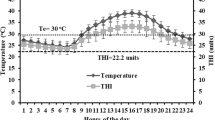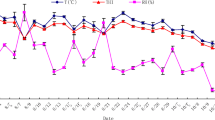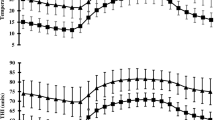Abstract
Twenty Dorper × Pelibuey primiparous ewes were used to evaluate effects of seasonal ambient heat stress (i.e., spring vs. summer) on physiological and metabolic responses under production conditions in an arid region. Ten ewes experiencing summer heat stress (i.e., temperature = 34.8 ± 4.6 °C; THI = 81.6 ± 3.2 units) and 10 under spring thermoneutral conditions (temperature = 24.2 ± 5.4 °C; THI = 68.0 ± 4.8 units) were corralled together to measure rectal temperature, respiratory frequency, and skin temperatures at 0600, 1200, 1800, and 2400 h on four occasions over 40 days. Blood metabolite and electrolyte concentrations were also measured at 0600 and 1800 hours. Data were analyzed with a completely randomized design using repeated measurements in time. Rectal and skin temperatures, as well as respiratory frequency, were higher (P < 0.01) in summer than spring at all measured days. Blood serum glucose, cholesterol, triglycerides, and chlorine concentrations were lower (P < 0.01) in summer than spring at 0800 and 1800 hours. In contrast, summer heat stress increased (P < 0.01) blood urea and potassium concentrations at 0800 and 1800 hours. Compared with spring thermoneutral conditions, summer heat stress affected the physiological and metabolic status of hair breed ewes in an arid region, which included blood metabolite and electrolyte adjustments to efficiently cope with summer heat stress.


Similar content being viewed by others
References
Al-Haidary AA, Aljumaah RS, Alshaikh MA, Abdoun KA, Samara EM, Okab AB, Alfuraiji MM (2012) Thermoregulatory and physiological responses of Najdi sheep to environmental heat load prevailing in Saudi Arabia. Pak Vet J 32:515–519
Alhidary IA, Shini S, Al Jassim RAM, Gaughan JB (2012) Physiological responses of Australian Merino wethers exposed to high heat load. J Anim Sci 90:212–220
Avendaño-Reyes L (2012). Heat stress management for milk production in arid zones. Milk production—an up-to-date overview of animal nutrition, management and health. Prof. Narongsak Chaiyabutr (Ed.), ISBN: 978–953-51-0765-1, InTech, DOI: 10.5772/51299.
Blood DC (2002) Manual de Medicina Veterinaria (9 Ed.). Editorial McGraw-Hill/Interamericana de España. Pp. 1–790.
Cain IIIJW, Krausman PR, Rosenstock S, Turner JC (2006) Mechanisms of thermoregulation and water balance in desert ungulates. Wildlife Soc B 34:570–581
Correa MPC, Cardoso MT, Castanheria M, Landim AV, Dallago BSL, Louvandini H, McManus C (2012) Heat tolerance in three genetic groups of lambs in central Brazil. Small Ruminant Res 104:70–77
Gastelum-Delgado MA, Avendaño-Reyes L, Álvarez-Valenzuela FD, Correa-Calderón A, Meza-Herrera CA, Mellado M, Macías-Cruz U (2015) Conducta estral circanual en ovejas Pelibuey bajo condiciones áridas del noroeste de México. Rev Mex Cienc Pecu 6:109–118
González-Bulnes A, Meza-Herrera CA, Rekik M, Ben Salem H, Kridli RT (2011) Limiting factors and strategies for improving reproductive outputs of small ruminants reared in semi-arid environments. In: Degenovine KM (ed) Semi-arid environments: agriculture, water supply and vegetation. Nova Science Publishers, Inc., New York, pp. 41–62
Hahn GL (1999) Dynamic responses of cattle to thermal heat loads. J Dairy Sci 82(Suppl. 2):10–20
Hales JR, Brown GD (1974) Net energetic and thermoregulatory efficiency during panting in the sheep. Comp Biochem Physiol a Comp Physiol 49:135–190
Indu S, Sejian V, Naqvi SMK (2015) Impact of simulated heat stress on growth, physiological adaptability, blood metabolites and endocrine responses in Malpura ewes under semiarid tropical environment. Anim Prod Sci 55:766–776
Kalyan De, Kumar D, Singh AK, Sahoo A, Naqvi SMK (2014) Seasonal variation of physiological response in ewes of farmers’ flocks under semi-arid tropical environment. Biol Rhythm Res 45:397–405
López R, Pinto-Santini L, Perozo D, Pineda J, Oliveros I, Chacón T, Rossini M, Ríos AL (2015) Thermal comfort and growth of West African lambs grazing with and without access to artificial shade. Arch Zootec 64:139–146
Macías-Cruz U, Álvarez-Valenzuela FD, Correa-Calderón A, Díaz-Molina R, Mellado M, Avendaño-Reyes L (2013a) Thermoregulation of nutrient-restricted hair ewes subjected to heat stress during late pregnancy. J Therm Biol 38:1–9
Macías-Cruz U, Avendaño-Reyes L, Álvarez-Valenzuela FD, Torrentera-Olivera NG, Meza-Herrera CA, Mella-Bosque M, Correa-Calderón A (2013b) Growth and carcass characteristics of ewe lambs treated with zilpaterol hydrochloride during spring and summer. Rev Mex Cienc Pecu 4:1–12
Macías-Cruz U, Gastelum MA, Álvarez-Valenzuela FD, Correa-Calderón A, Díaz R, Meza-Herrera CA, Mellado M, Avendaño-Reyes L (2015) Effects of summer heat stress on physiologic variables, ovulation and progesterone secretion in Pelibuey ewes under natural outdoor conditions in an arid region. Anim Sci J. doi:10.1111/asj.12430
Mader TL, Dahlquist JM, Hahn GL, Gaughan JB (1999) Shade and wind barrier effects on summer-time feedlot cattle performance. J Anim Sci 77:2065–2072
Marai IFM, El-Darawany AA, Fadiel A, Abdel-Hafez MAM (2007) Physiological traits as affected by heat stress in sheep—a review. Small Ruminant Res 71:1–12
Marai IFM, El-Darawany AA, Fadiel A, Abdel-Hafez MAM (2008) Reproductive performance traits as affected by heat stress and its alleviation in sheep. Trop Subtrop Agroecosys 8:209–234
McManus C, Louvandini H, Gugel R, Sasaki LCB, Bianchini E, Bernal FEM, Paiva SR, Paim TP (2011) Skin and coat traits in sheep in Brazil and their relation with heat tolerance. Trop Anim Health Prod 43:121–126
Monty DE, Kelly LM, Rice WR (1991) Acclimatization of St. Croix, Karakul and Rambouillet sheep to intense and dry summer heat. Small Ruminant Res 4:379–392
Neves MLMW, de Azecedo M, da Costa LAB, Guim A, Leite AM, Chagas JC (2009) Critical levels of the thermal comfort index for Santa Ines sheep under grazing at the agreste region of Pernambuco state. Acta Sci Anim Sci 31:169–175
Niyas AAA, Chaidayna K, Shaji S, Sejian V, Bhatta R, Bagath M, Rao GHSLVP, Kurien EK, Girish V (2015) Adaptation of livestock to environmental challenges. J Vet Sci Med Diagn 4:3
Piccione G, Messina V, Vazzana I, Dara S, Giannetto C, Assenza A (2012) Seasonal variations of some serum electrolyte concentrations in sheep and goats. Comp Clin Pathol 21:911–915
Pinto-Santini L, Ríos AL, Oliveros I, Pigliacampo A, Chacón T (2014) Shadow effect at grazing on some physiological variables of West African lambs under emergency conditions of mild heat. Livest Res Rural Develop 26:1–11
Ramana DBV, Pankaj PK, Nikhila M, Rani R, Sudheer D (2013) Productivity and physiological responses of sheep exposed to heat stress. J Agrometeorol (Special issue):71–76
Rashid MM, Hossain MM, Azad MAK, Hashem MA (2013) Long term cyclic heat stress influences physiological responses and blood characteristics in indigenous sheep. Bangladesh J Anim Sci 42:96–100
Rasooli A, Nouri M, Khadjeh GH, Rasekh A (2004) The influence of seasonal variations on thyroid activity and some biochemical parameters of cattle. Iran J Vet Res 5:1383–1391
Robinson NE (2002) Hemostasis. In: Textbook of vet physiology, second edition, editors, J. G. Cunningham. St Louis: W. B. Saunders Company, pp 516–544
Romero RD, Pardo AM, Montaldo HH, Rodríguez AD, Cerón JH (2013) Differences in body temperature, cell viability, and HSP-70 concentrations between Pelibuey and Suffolk sheep under heat stress. Trop Anim Health Pro 45:1691–1696
Ross TT, Goode L, Linnerud AC (1985) Effects of high ambient temperature on respiration rate, rectal temperature, fetal development and thyroid gland activity in tropical and temperate breeds of sheep. Theriogenology 24:259–269
Russel AJF, Doney JM, Gunn RJ (1969) Subjective assessment of body fat in live sheep. J Agric Sci 72:451–454
SAS (2004) SAS/STAT: User’s guide statistics released 9.1, 2nd Ed. SAS Institute, Inc. Cary, NC, USA.
Sejian V, Indu S, Naqvi SMK (2013) Impact of short term exposure to different environmental temperature on the blood biochemical and endocrine responses of Malpura ewes under semi-arid tropical environment. Indian J Anim Sci 83:1155–1160
Sejian V, Maurya VP, Naqvi SMK (2010) Adaptability and growth of Malpura ewes subjected to thermal and nutritional stress. Trop Anim Health Prod 42:1763–1770
Silanikove N (2000) Effects of heat stress on the welfare of extensively managed domestic ruminants: a review. Livest Prod Sci 67:1–18
Srikandakumar A, Johnson EH, Mahgoub O (2003) Effect of heat stress on respiratory rate, rectal temperature and blood chemistry in Omani and Australian Merino sheep. Small Ruminant Res 49:193–198
Tabarez-Rojas A, Porras-Almeraya A, Vaquera-Huerta H, Hernández-Ignacio J, Valencia J, Rojas-Maya S, Hernández-Cerón J (2009) Embryonic development in Pelibuey and Suffolk ewes under heat stress conditions. Agrociencia 43:671–680
Wildeus S (1997) Hair sheep genetic resources and their contribution to diversified small ruminant production in the United States. J Anim Sci 75:630–640
Acknowledgments
This study was supported through the first author by the PROMEP-SEP program in the 2011, likewise by the Autonomous University of Baja California, Mexico. The authors thank Yolanda Osorio and Samantha Perard for their technical assistance in the development of the current study.
Author information
Authors and Affiliations
Corresponding author
Ethics declarations
All procedures involving sheep were conducted within the guidelines of approved local official techniques of animal care in Mexico (NOM-051-ZOO-1995: humanitarian care of animals during mobilization).
Conflict of interest
The authors declare that they have no competing interests.
Rights and permissions
About this article
Cite this article
Macías-Cruz, U., López-Baca, M.A., Vicente, R. et al. Effects of seasonal ambient heat stress (spring vs. summer) on physiological and metabolic variables in hair sheep located in an arid region. Int J Biometeorol 60, 1279–1286 (2016). https://doi.org/10.1007/s00484-015-1123-6
Received:
Revised:
Accepted:
Published:
Issue Date:
DOI: https://doi.org/10.1007/s00484-015-1123-6




